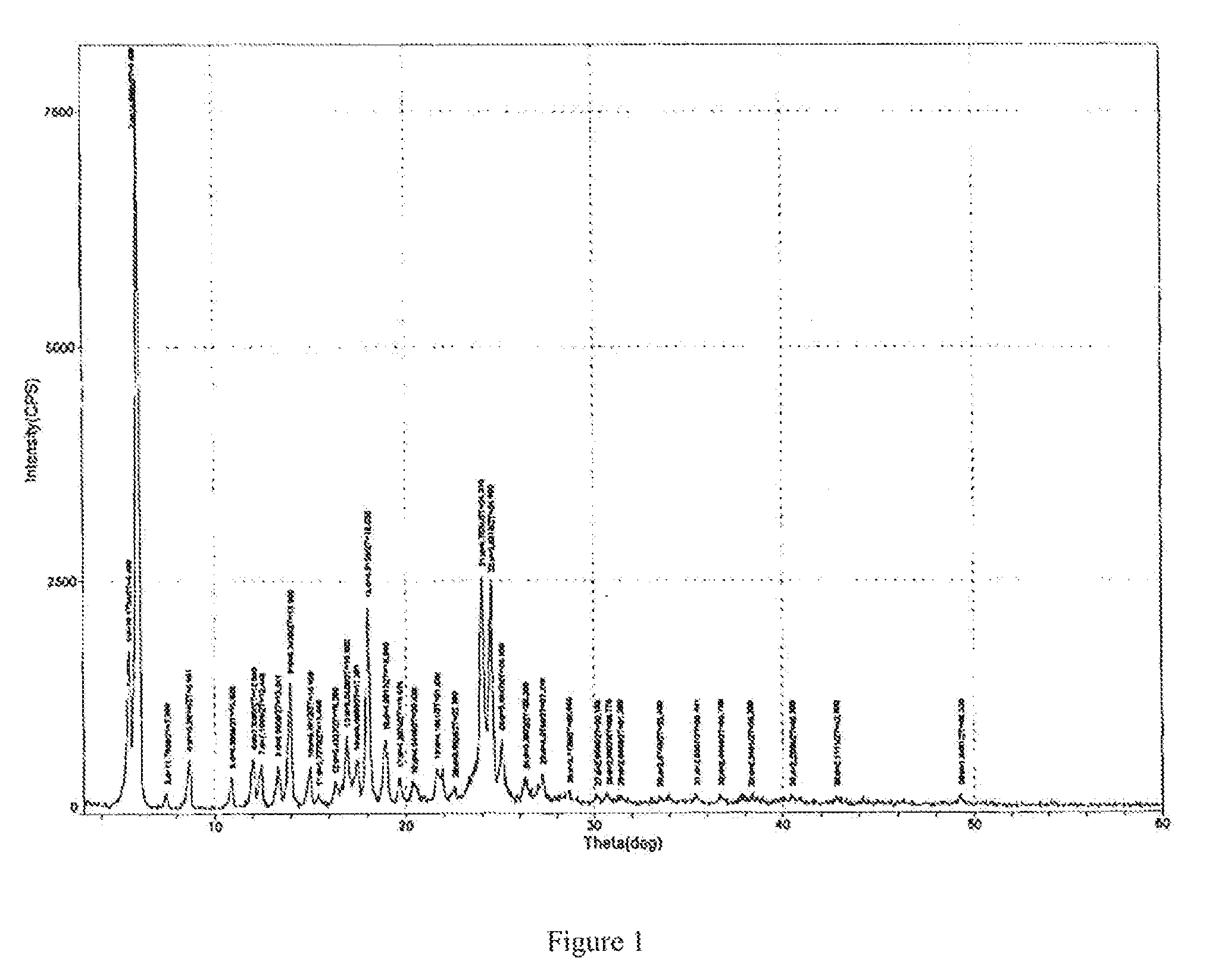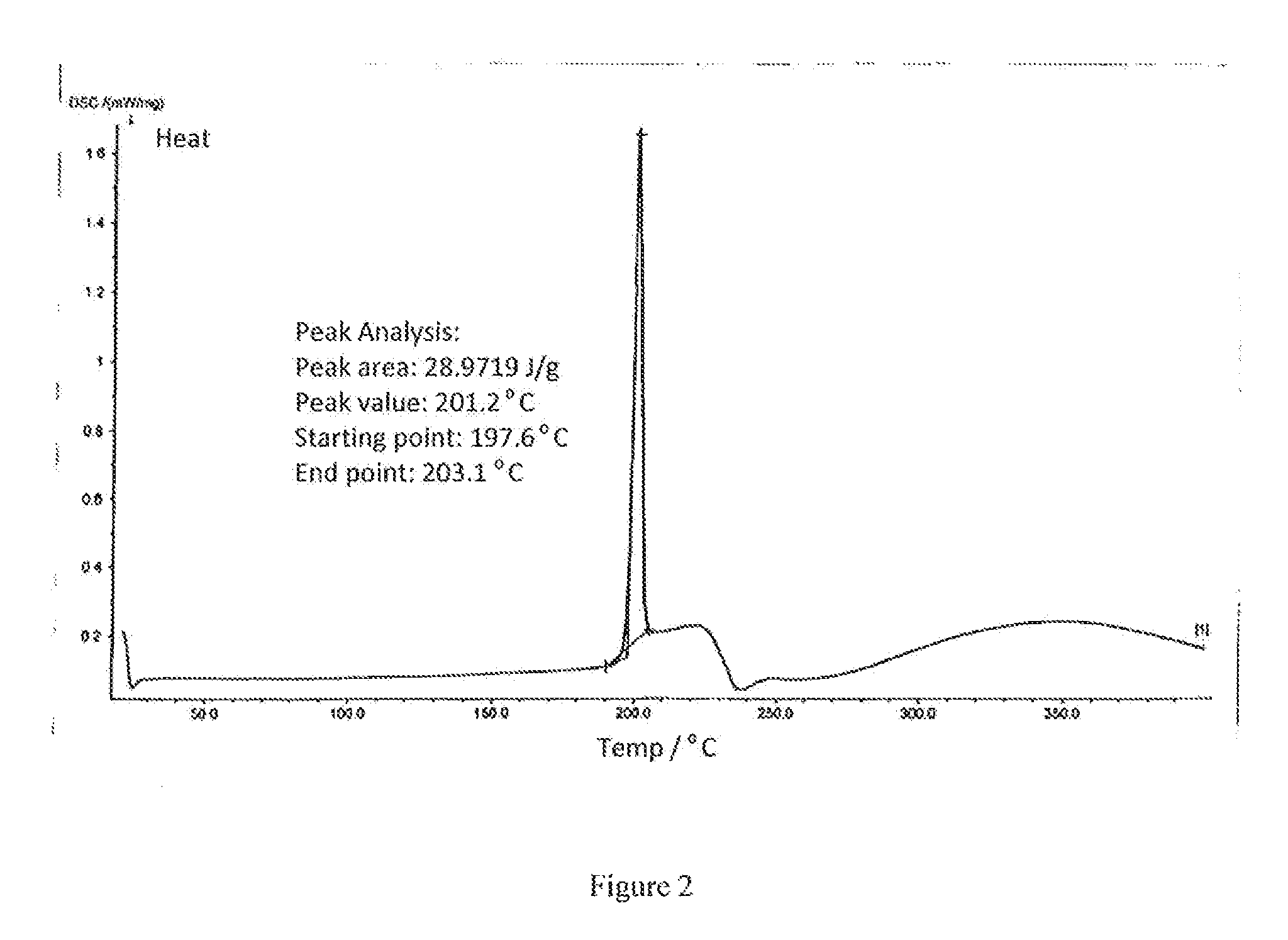Crystalline form of 2-((1′-n-hexyloxy) ethyl)-2-divinyl-pyropheophorbide-a and method for preparing thereof
a technology of pyropheophorbide and crystalline form, which is applied in the field of crystalline form of hpph (2((1′nhexyloxy) ethyl)2divinylpyropheophorbidea) and the method of preparing thereof, can solve the problems of significant affecting the stability, solubility and bioavailability of a drug, and achieves the effects of small crystal size, short filtration time and stable structur
- Summary
- Abstract
- Description
- Claims
- Application Information
AI Technical Summary
Benefits of technology
Problems solved by technology
Method used
Image
Examples
embodiment 1
[0025]In a 2 liter eggplant shaped flask, measuring into 17.5 g of HPPH sample (prepared according to the preparation process disclosed in U.S. Pat. No. 5,198,460), adding 100 ml of acetone, stirring, heating with a water bath (40° C. to 45° C.), after the solid is completely dissolved, adding 1050 ml of n-heptane, continuously stirring for 10 minutes, standing undisturbed (at 5° C. to 10° C.) for 6 hrs, filtering, washing filter cake with 100 ml of n-heptane, drying in a vacuum (a vacuum degree greater than 0.9 MPa, at the temperature of 40° C.), so as to obtain 14.2 g of crystalline HPPH product. Next, using Rigaku D / max-2200 (Cu target; voltage: 40 kV; current: 40 mA; Scanning condition: continuous scanning; initial angle: 3°, end angle: 40°, scanning speed: 4 / min., Scanning width: 0.01°) to detect XRD pattern of the obtained HPPH product, and using NETZSCH DSC 204 (initial temperature: 20° C.; end temperature: 400° C.; temperature increasing rate: 10.0 K / min) to detect DSC patte...
embodiment 2
[0026]In a 10 liter four necked flask, measuring into 90 g of HPPH sample (prepared according to the preparation process disclosed in U.S. Pat. No. 5,198,460), adding 1.2 liters of ethyl acetate, stirring, heating with a water bath (40° C. to 45° C.), after the solid is completely dissolved, adding 7 liters of n-heptane, continuously stirring for 10 minutes, standing undisturbed (5° C. to 10° C.) for 4 hrs, filtering, washing filter cake with 500 ml of n-heptane, drying in a vacuum (vacuum degree greater than 0.9 MPa, at the temperature of 40° C.), so as to obtain 81.3 g of crystalline HPPH product. With analysis of the XRD pattern (with the same detection condition as described in Embodiment 1), the crystal obtained here is the same as the crystal obtained in Embodiment 1.
embodiment 3
[0027]In a 10 liter eggplant shaped flask, measuring into 51.9 g of HPPH sample (prepared according to the preparation process disclosed in U.S. Pat. No. 5,198,460), adding 400 ml of ethyl acetate, stirring, heating with a water bath (40° C. to 45° C.), after the solid is completely dissolved, adding 3 liters of n-heptane, continuously stirring for 15 minutes, incubating (5° C. to 10° C.) while stirring for 6 hrs, filtering, washing filter cake with 200 ml of n-heptane, drying in a vacuum (vacuum degree greater than 0.9 MPa, at the temperature of 40° C.), so as to obtain 41.4 g of crystalline HPPH product. With analysis of the XRD pattern (with the same detection condition as described in Embodiment 1), the crystal obtained here is the same as the crystal obtained in Embodiment 1.
PUM
| Property | Measurement | Unit |
|---|---|---|
| temperature | aaaaa | aaaaa |
| temperature | aaaaa | aaaaa |
| temperature | aaaaa | aaaaa |
Abstract
Description
Claims
Application Information
 Login to View More
Login to View More - R&D
- Intellectual Property
- Life Sciences
- Materials
- Tech Scout
- Unparalleled Data Quality
- Higher Quality Content
- 60% Fewer Hallucinations
Browse by: Latest US Patents, China's latest patents, Technical Efficacy Thesaurus, Application Domain, Technology Topic, Popular Technical Reports.
© 2025 PatSnap. All rights reserved.Legal|Privacy policy|Modern Slavery Act Transparency Statement|Sitemap|About US| Contact US: help@patsnap.com



